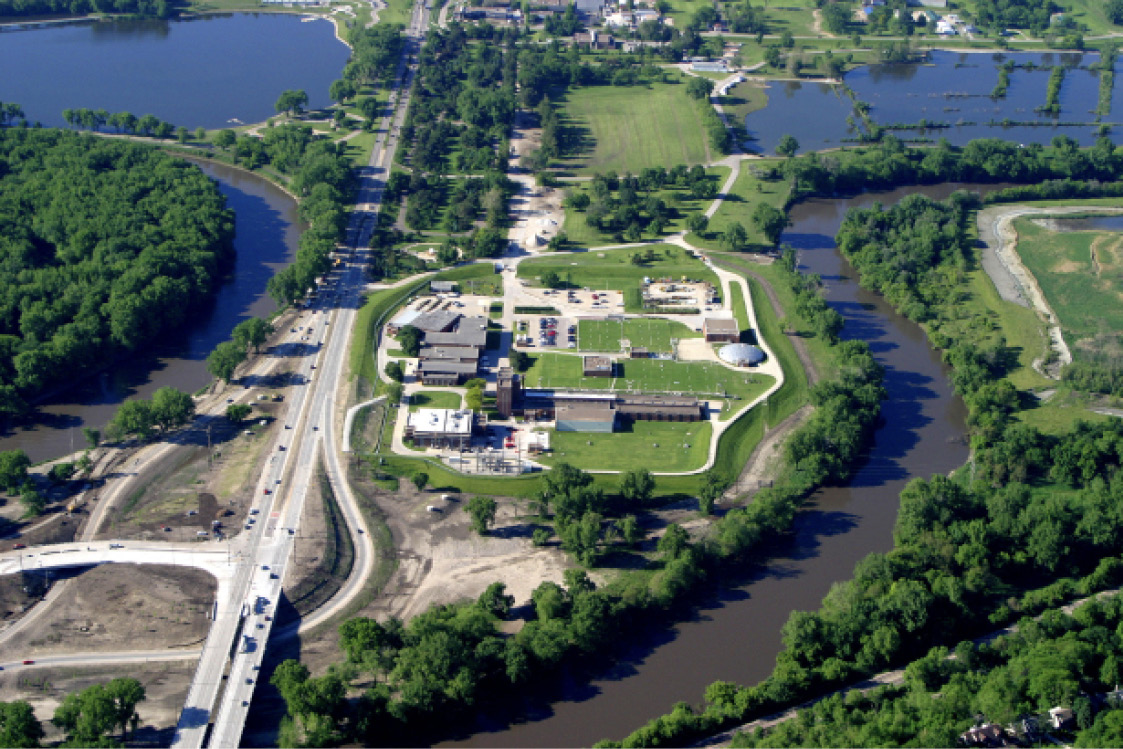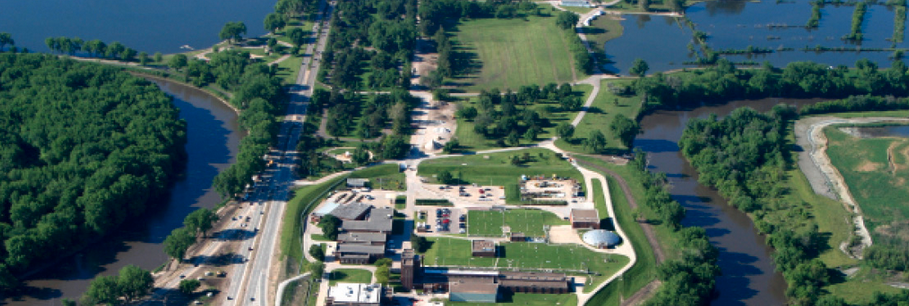Abstract
Des Moines Water Works, the largest drinking water utility in Iowa, filed a federal lawsuit in March 2015, against the Boards of Supervisors in three northwest Iowa counties as trustees of public drainage systems designed to drain agricultural lands, claiming these violate state and federal laws by polluting the Raccoon River (one of the utility’s primary water sources). This action was taken only after it became clear that Iowa’s surface water quality immediately threatens public health and that past collaborative efforts had provided no meaningful consumer and environmental protection. This lawsuit will be heard in August 2016, in Federal District Court, Sioux City, Iowa, and raises novel legal and cultural issues both locally and nationally.
Background
Since its inception as a private water company in 1871, Des Moines Water Works’ mission has been to provide safe, affordable, and abundant water to its customers. As the population of its customers (now approximately 500,000 customers in Des Moines and surrounding metro communities) has changed, so has the quality of the utility’s source water taken from the Raccoon and Des Moines Rivers. Once, outhouses, upstream sewage, and septic tanks were the main causes of pollution. Today, industrial scale agricultural land practices are the cause of most water quality concerns for the Des Moines Water Works. The intensive corn-soybean cropping system that occupies much of Des Moines Water Works’ watersheds “requires” tile drainage beneath farm fields and the application of massive amounts of fertilizer to maximize yields. We see application of manure from growing animal feeding operations and unlimited application of commercial fertilizer. These and other pollutants are then conveyed to waterways through drainage systems. All of this has significantly, and increasingly, degraded water quality.
As consumers, we think of “nutrients” as something good and even necessary to support maximum crop yields. But pollution occurs when the amount of nutrients applied to land are more than can be used by plants; when this occurs, artificial drainage carries these excess amounts into our rivers and lakes
Under the Safe Drinking Water Act, Des Moines Water Works is required to meet the United States Environmental Protection Agency’s standards for the maximum contaminate level (MCL) in its finished drinking water. The MCL standard for nitrate is 10 mg/L (or 10 parts per million). The health risks associated with nitrate contamination above MCL include Methaemoglobinemia, also known as “blue baby syndrome,” where infants under six months of age who consume water over 10 mg/L may lose the ability to transport oxygen. It is unknown how higher nitrate levels affect the broader population, but researchers are studying potential impacts. In addition to public health risks to drinking water, nitrate pollution also contributes to the hypoxic conditions in public waters, including the Gulf of Mexico’s “Dead Zone.”
In 1989 and 1990, the water flowing from Des Moines Water Works exceeded the EPA’s standard for nitrate in drinking water. Des Moines Water Works’ current nitrate removal facility was designed in 1989 and was built in 1990-1991, at a cost of $4.1 million, so that the utility could produce water that meets federal drinking water standards.
Since then, the nitrate removal facility—the world’s largest such facility—has seen increasing use. At the time of this writing, in 2015, Des Moines Water Works has operated the denitrification system a record 148 days, up from a previous annual record of 108 days. This nitrate removal process adds an extra four to seven thousand dollars per day in operating costs of treating water, and the facility is reaching the end of its life cycle. In addition, reliance on an ionization process for nitrate removal is no longer acceptable to environmental groups due to waste disposal issues.
While Des Moines Water Works has invested millions of dollars in capital infrastructure and has developed strategies to manage high nitrate levels, record nitrate peaks in source waters continue to threaten the security of the water supply and the ability of Des Moines Water Works to deliver safe and reliable water, affordably to its consumers.
Little Regard for Downstream
It’s a saying in farming that well-drained soil leads to higher yields. In simple terms, subsurface drainage tile is farm field plumbing—drainage pipes moving water off land with no regard for water quality or water quantity. The once swampy land of the Des Moines Lobe (also known as Prairie Pothole Region) was transformed into farmable land beginning in the 1890s through farm field drainage systems. A 1910 New York Times article wrote about the extraordinary feat: “Iowa farmers have been arranging drainage improvements in their low lands at a cost that will come within $85,000 of equaling the expense of building the Panama Canal. The general public has little conception of the extent of the enterprise which will increase the value of Iowa lands by millions of dollars.” 1
Drainage districts were formed as public utilities under Iowa legislation. Districts have taxing authority over benefited farms and are overseen by Boards of Supervisors in the counties they serve or by elected trustees. Under Iowa law, drainage districts are responsible for constructing, administering, and maintaining drainage infrastructure.
The primary source of nitrate pollution in the Raccoon River watershed is artificial subsurface drainage system infrastructure, such as those created and managed by drainage districts. There are thousands of drainage districts in the Des Moines Lobe, including hundreds located in the three northwest Iowa counties of Buena Vista, Calhoun and Sac.
History of “Partnerships”
For the last two decades, nitrate levels in both the Des Moines and Raccoon Rivers have been peaking at concentrations and loads dangerous to humans. For even longer, Des Moines Water Works representatives have been engaged in discussions and have served on numerous study commissions, task forces and similar cooperative efforts with the state of Iowa, local governments, businesses, agricultural interests, academia, citizen groups, and individuals to explore ways to stem this threat to Iowa and Iowans. Efforts such as these are only successful when those who begin on opposite sides of an issue are able to put their own interests aside and acknowledge the difficulties their counterparts face.

Photo Courtesy of Des Moines Water Works
Unfortunately, efforts at cooperation and collaboration between Des Moines Water Works, as a producer of safe drinking water, and farm groups, including corn, soybean, hog, poultry and cattle producers, have led to no sustainable improvements in Iowa surface water quality. In fact, record levels of nitrate concentrations on any single day have been recently set on the Raccoon and Des Moines Rivers while the denitrification efforts of the Des Moines Water Works have been used more frequently in 2015 than ever before in its history. Moreover, the Iowa Farm Bureau, a profoundly active participant in Iowa politics at all levels, has vehemently pushed back on any challenges to the notion that agricultural practices should be more heavily regulated, particularly as it might benefit greater environmental protection. Iowa Farm Bureau representatives have called Des Moines Water Works’ leadership “un-Iowan.”
Flawed Strategy
The Mississippi River/Gulf of Mexico Watershed Nutrient Task Force was established in 1997 to coordinate activities to reduce the size, severity and duration of hypoxia in the Gulf. In its 2008 Action Plan, the task force called upon each of the 12 states along the Mississippi River to develop its own nutrient reduction strategy. The Iowa Nutrient Reduction Strategy was introduced to the public in 2012 to reduce the state’s contribution of nutrients in rivers, streams and lakes by 45 percent. Unfortunately, Iowa’s Nutrient Reduction Strategy places agriculture’s interests first to the exclusion of public health and environmental interests. Under this scheme, the people of Iowa are left to blindly trust that those upstream are taking steps to improve water quality.
With science and technology of the strategy developed by Iowa State University, Iowa Department of Natural Resources and Iowa Department of Agricultural and Land Stewardship, the strategy was heavily influenced by Iowa Farm Bureau and other agricultural interest groups to support voluntary, non-regulatory land uses. According to the strategy’s science, the estimated nitrate contribution to Iowa’s rivers and lakes is shown to be 92 percent from agriculture and eight percent from communities and industries; however, the Strategy’s policy regulates small town, suburban, and urban water and sewer users, while advocating for “voluntary” conservation practices from agricultural producers and ignoring the role of unregulated, large scale, agricultural drainage infrastructure in transporting nutrients from field to stream.
The voluntary approach for agricultural sources fundamental to the Strategy lacks quantifiable and credible data, timeframes to measure progress, and adequate funding. However, management of Iowa’s water resources will take commitment (including regulation), appropriate water quality measures, and sustainable funding. Vital ingredients to water quality improvements includes regulation monitoring, and sustained public and private funding.
Des Moines Water Works Seeks Remedies
Since the launch of the Nutrient Reduction Strategy, Des Moines Water Works has experienced two unprecedented nitrate episodes and associated costs for the treatment of the pollutant. In 2013, when nitrate levels in the Raccoon and Des Moines Rivers reached record highs in each river of 24.39 mg/L and 18.62 mg/L, respectively, Des Moines Water Works incurred approximately $900,000 in treatment costs and lost revenues. Various denitrification efforts in 2014 and 2015, including operation of the Nitrate Removal Facility for a record 148 days in 2015, have had direct operational costs of over $1,500,000.
Moreover, continued high nitrate concentrations in the Des Moines and Raccoon Rivers will require future capital investments to remove the pollutant and provide safe drinking water to a growing central Iowa population. Des Moines Water Works is now actively planning for capital investments currently estimated to cost $76-183 million, a cost funded by ratepayers, for new denitrification technology in order to remove pollutants and continue to provide safe drinking water.
Concerned with the continued high levels of nitrate in its watershed, costs associated with denitrification passed onto customers, and little action from state and agricultural industry leaders, Des Moines Water Works began its investigation into significant upstream nutrient polluters.
Des Moines Water Works sampled 72 public, right-of-way sites in three upstream counties for nearly a year. These sites were identified as places where agricultural land practices are the sole contributor of the nitrate pollution. Lab results showed nitrate levels as high as 39.2 mg/L in groundwater discharged by the drainage districts—nearly four times the federally required Safe Drinking Water regulatory limit of 10 mg/L. These results correlated with measurements by the United States Geologic Survey (USGS), a scientific agency in the United States government, at monitoring sites along the Raccoon River in close proximity to these industrial agricultural polluters.
In January of 2015, Des Moines Water Works staff recommended to the Board of Water Works Trustees to issue a Notice of Intent to Sue to the Boards of Supervisors of Buena Vista, Calhoun and Sac Counties in their capacities as trustees of 10 drainage districts, for the discharge of nitrate pollutants into the Raccoon River. The notice is a required 60-day notification under the citizen suit provision of the Federal Water Pollution Control Act (commonly known as the Clean Water Act) and Iowa Code Chapter 455B.
With no negotiated solutions after the 60-day notice, the Board of Water Works Trustees filed a federal complaint on March 16, 2015. The case is currently in the discovery phase and is scheduled for trial in August 2016, in Federal District Court, Sioux City, Iowa.
The complaint seeks to declare the named drainage districts as “point sources,” not exempt from regulation, and required to have a permit under federal and Iowa law, just as any other business that discharges in the waters of Iowa. The complaint states that the drainage districts have violated and continue to violate the Federal Clean Water Act, Chapter 455B, Code of Iowa (involving permitting for discharges into state waters) and public nuisance laws.
Des Moines Water Works demands agricultural accountability from the drainage districts, requiring them to take all necessary actions to comply with existing law, including ceasing all discharges of nitrate that are not authorized by a National Pollutant Discharge Elimination System (NPDES) permit.
In addition, damages are demanded by Des Moines Water Works to compensate for the harm caused by the drainage districts’ unlawful discharge of nitrate, and to award litigation costs and reasonable attorney fees to Des Moines Water Works as authorized by law.
Implications of Agricultural Regulation
Des Moines Water Works is not seeking to change agriculture methods, but rather to challenge governments, including drainage districts, Iowa Department of Natural Resources and United States Environmental Protection Agency, to better manage and control drainage infrastructure in order to improve water quality within the state.
“Precision agriculture” and the use of technology to balance agricultural needs with the consequences to downstream users hold tremendous potential for making Iowa more productive and safe for everyone.
Abusive land use, artificial drainage systems, and intensive nutrient applications by industrial agriculture are the root causes that continue to be left unregulated. Instead of the obstructionism we see by agricultural organizations, we need consumers to understand the consequences of deteriorating water quality to downstream users and to provide a venue to openly and honestly discuss water quality issues and solutions. Iowa will be a more productive state and draw new businesses, industries, and employees to the state when water quality improves.
Political Push Back
Since the federal lawsuit was filed, there have been many attention-grabbing headlines from political leaders. These have ranged from Governor Terry Brandstad (R) stating that Des Moines has “declared war on rural Iowa,” 2 and “Des Moines Water Works ought to just tone it down” 3 to State Sen. Randy Feenstra (R-Hull) encouraging Iowans to boycott Des Moines, 4 and his promise to introduce state legislation to block the lawsuit. 5 In so doing, state political leadership continues to sidestep any meaningful action that would help reverse the state’s ongoing environmental decline.
Outcomes: Public Health Protection and Improved Waterways
It is important to remember that this issue is not about run-off from farm fields. Today’s highly engineered and increasingly efficient drainage systems move groundwater infused with nitrate from intensive agriculture operations directly through a complex system of pipes to the stream heads and rivers that serve as the water source for a large portion of the state. If left to its natural course, much of this groundwater would never move into rivers and streams and that which does would be filtered through a natural process that would reduce the nitrate concentration considerably.
Des Moines Water Works is seeking agreement on a few simple facts, including the notion that entities such as agricultural drainage districts should be subject to reasonable standards and assume responsibility for altering the hydrology of Iowa’s waters.
Dumping polluted groundwater into the waterways is causing significant environmental damage and putting people downstream at risk. Drainage districts must seek and receive the same permit that other entities do, and the water being handled by drainage districts must be required to meet reasonable standards before being dumped into the water system we all rely upon to survive.
Des Moines Water Works remains committed, first and foremost, to protecting Iowa’s water by holding agriculture accountable for environmental protection like any other activity. The utility is hopeful that this objective can be reached short of prolonged litigation through good faith efforts to reach acceptable public policy outcomes that materially improve clean water protections. If not, Des Moines Water Works is committed to compelling regulators to protect our community from the adverse health consequences of upstream polluters who have established an extensive history of draining their farm fields without any regard to the water quality and water quantity consequences downstream.
Summary
Iowans take great pride in their history of agricultural prosperity, sometimes claiming to “feed the world.” Picturesque images of rolling fields of corn and symmetric red barns are more than Iowa kitsch. They’re a vision of an Iowa untouched by increasing consolidation characteristic of international markets and reliance on corn, soybeans and hog production to support the dwindling economies of rural Iowa and the giant insurance, chemical and equipment manufactures that prosper under the status quo’s “voluntary” environmentalism. Economic justice, social justice, and demographic factors must lead to greater accountability in agricultural production that will protect both consumers and producers by reflecting social costs from agricultural production in the costs borne by those who profit to the detriment of those downstream.
1 Paying $307,000,000 for Iowa Drainage. (1910, September 23). The New York Times.
2 Petroski, W. (2015, January 13). Branstad: “Des Moines has declared war on rural Iowa” The Des Moines Register.
3 Petroski, W. (2015, July 28). Branstad: Water Works should ‘tone down’ criticism of ag pollution. The Des Moines Register.
4 Petroski, W. (2015, March 19). Rural lawmaker calls for boycotting Des Moines over Water Works lawsuit. The Des Moines Register.
5 Petroski, W. (2015, September 20). Boycott flops, bill eyed to stop Water Works lawsuit. The Des Moines Register.


